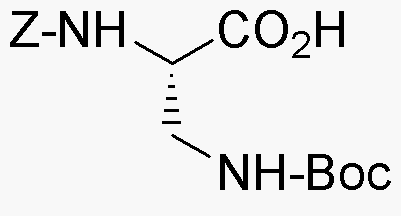Na-Z-Nb-Boc-L-2,3-diaminopropionic acid is widely utilized in research focused on:
- Peptide Synthesis: This compound serves as a valuable building block in the synthesis of peptides, allowing researchers to create complex molecules for drug development and biological studies.
- Drug Design: Its unique structure enables the design of novel pharmaceuticals, particularly in the development of targeted therapies for various diseases, including cancer.
- Bioconjugation: The chemical is used in bioconjugation processes, facilitating the attachment of biomolecules to drugs or imaging agents, enhancing their effectiveness and specificity.
- Research in Neuroscience: This compound is explored for its potential in neuroprotective studies, contributing to the understanding of neurological disorders and the development of new treatments.
- Material Science: Its properties are leveraged in creating advanced materials, such as hydrogels, which have applications in drug delivery systems and tissue engineering.
General Information
Properties
Safety and Regulations
Applications
Na-Z-Nb-Boc-L-2,3-diaminopropionic acid is widely utilized in research focused on:
- Peptide Synthesis: This compound serves as a valuable building block in the synthesis of peptides, allowing researchers to create complex molecules for drug development and biological studies.
- Drug Design: Its unique structure enables the design of novel pharmaceuticals, particularly in the development of targeted therapies for various diseases, including cancer.
- Bioconjugation: The chemical is used in bioconjugation processes, facilitating the attachment of biomolecules to drugs or imaging agents, enhancing their effectiveness and specificity.
- Research in Neuroscience: This compound is explored for its potential in neuroprotective studies, contributing to the understanding of neurological disorders and the development of new treatments.
- Material Science: Its properties are leveraged in creating advanced materials, such as hydrogels, which have applications in drug delivery systems and tissue engineering.
Documents
Safety Data Sheets (SDS)
The SDS provides comprehensive safety information on handling, storage, and disposal of the product.
Product Specification (PS)
The PS provides a comprehensive breakdown of the product’s properties, including chemical composition, physical state, purity, and storage requirements. It also details acceptable quality ranges and the product's intended applications.
Certificates of Analysis (COA)
Search for Certificates of Analysis (COA) by entering the products Lot Number. Lot and Batch Numbers can be found on a product’s label following the words ‘Lot’ or ‘Batch’.
*Catalog Number
*Lot Number
Certificates Of Origin (COO)
This COO confirms the country where the product was manufactured, and also details the materials and components used in it and whether it is derived from natural, synthetic, or other specific sources. This certificate may be required for customs, trade, and regulatory compliance.
*Catalog Number
*Lot Number
Safety Data Sheets (SDS)
The SDS provides comprehensive safety information on handling, storage, and disposal of the product.
DownloadProduct Specification (PS)
The PS provides a comprehensive breakdown of the product’s properties, including chemical composition, physical state, purity, and storage requirements. It also details acceptable quality ranges and the product's intended applications.
DownloadCertificates of Analysis (COA)
Search for Certificates of Analysis (COA) by entering the products Lot Number. Lot and Batch Numbers can be found on a product’s label following the words ‘Lot’ or ‘Batch’.
*Catalog Number
*Lot Number
Certificates Of Origin (COO)
This COO confirms the country where the product was manufactured, and also details the materials and components used in it and whether it is derived from natural, synthetic, or other specific sources. This certificate may be required for customs, trade, and regulatory compliance.


